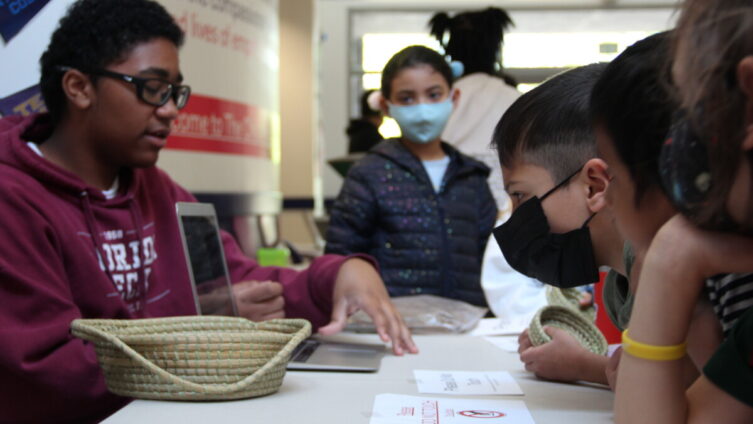
By Carl Parke
TCS Eighth Grade Teacher
The Children’s School’s eighth graders engage every year in a project-based learning unit on Gullah Geechee culture, a unique American-Creole culture found mainly along the coast of South Carolina, Georgia, Florida and North Carolina. The lessons in the PBL unit help prepare our class for two, week-long trips to the Georgia Coast and a Gullah Geechee Expo for the entire school.
The roots of Gullah Geechee extended to Africa and matured in the coastal regions of the Southeastern United States during and after the era of enslavement. Isolated largely due to geography, Gullah Geechee people leaned on their connections to each other and what we know today as Gullah Geechee culture developed over time. Economic issues, especially those related to land ownership and job opportunities, faced Gullah Geechee people living within the Gullah Geechee Cultural Heritage Corridor.
In the first lesson in the unit, I asked students to imagine they were walking down a street in a foreign country and encountered someone with traits that demonstrated that person was American. Students generated a list of cultural markers including language, clothing, food, music, and pastimes.
In the winter, we spoke with Dr. Jessica Berry, a South Carolina State University professor who researches Gullah Geechee history, culture and language, via Zoom to discuss Gullah Geechee culture in general and language in particular. The call with Dr. Berry led to a class discussion centered on the lyrical sound of the language and helped foster additions to the list of cultural traits to research.
An important part of our unit, and Gullah Geechee culture, is food. With approximately a month between the launch of the unit and the trip to the Georgia coast, we cooked a dish each week from Matthew Raiford’s “Bress ‘N’ Nyam,” which included pancakes, Gullah rice, Sapelo Red Peas, and grits. Pancakes proved to be a fairly controversial dish since they were served with cane syrup as opposed to maple syrup and the batter called for a generous percentage of corn meal.
Each time we cooked a new dish, we discussed how that dish arose within the Gullah Geehcee culture. We learned about the prevalence of sugar cane as opposed to maple trees as a source of a sweetener and the prevalence of corn over wheat in local agriculture. One-pot dishes such as Gullah rice and Hoppin’ John were also topics of discussion.
In addition to food, we learned about music and storytelling in the Gullah Geechee culture by exploring online recordings by the Sea Island Singers, the McIntosh County Shouters, and Diane Ferlatte.
We read readings from a variety of sources chosen to provide further foundational knowledge of the Georgia coast and Sapelo Island to learn more about the history of the Gullah Geechee people in Georgia. We also used Amy Lotson Roberts’ book “Gullah Geechee Heritage in the Golden Isles” to build our foundational knowledge of Gullah Geechee history and culture.
We also studied online sources from organizations such as SOLO and SICARS about the current efforts on Sapelo Island to preserve Gullah Geechee culture and read about a recently settled lawsuit brought by Sapelo Island residents against McIntosh County.
The work prior to the trip was designed to help ensure we had a firm foundation in the history of the Gullah Geechee, an understanding of issues facing the Gullah Geechee today, and various approaches to preserving the group’s culture.
In the winter and spring, we visited the Georgia coast to visit some of the places we studied. Each night students spent time reflecting on that day’s events and generating a list of questions for the next day’s activities.
During the trip, we took a tour of Sapelo Island with Yvonne Grovner, a resident of the island. She also led the class through a sweetgrass basket-weaving demonstration. The next day, we kayaked in the salt marsh around Brunswick to gain a deeper understanding of the importance of the coastal wetlands to the Gullah Geechee.
After kayaking, we visited with Amy Lotson Roberts at the Harrington School. In addition to having attended the school, Amy currently helps lead the Saint Simons African American Heritage Association.
At the end of the trip, we visited Matthew Raiford at Gilliard Farms for a tour of the farm. We learned the history of the farm and the sustainable farming techniques he utilizes on the farm.
Upon returning to Atlanta, the students worked individually or in small groups to do a deep dive into one aspect of Gullah/Gechee culture. Some of the cultural traits students generated for the gallery walk included language, food, watch night, sweetgrass basket weaving, the ring shout, and crafts such as cast net making. That research culminated in a Gullah Geechee Cultural Exposition for other students at TCS to learn about Gullah Geechee culture.
Earlier this month, we were excited to learn that The Gullah Geechee Cultural Heritage Corridor, a National Heritage Area established by the U.S. Congress to recognize the unique culture of the Gullah Geechee people, awarded our PBL unit third place in their Culture Keeper Classroom Competition.









